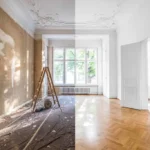
Home décor doesn’t always require a professional touch or an expensive budget. With the right tips and tricks, you can create a stunning home environment by rolling up your sleeves and embarking on some DIY projects. Whether you’re a seasoned DIYer or just starting, there are countless small, budget-friendly changes you can make to refresh your space. In this blog, we’ll explore several DIY tips and tricks that can transform your home, from easy-to-execute design changes to clever hacks that can elevate the look and feel of any room.
1. Repurpose Old Furniture
One of the easiest ways to breathe new life into your home is by repurposing old furniture. With a few adjustments and some creativity, you can transform dated or worn-out pieces into beautiful statement furniture.
Trick: Paint and Refinish
- Sand and Paint: A fresh coat of paint can make an old piece look brand new. Sand the furniture first to remove any rough areas, and then apply primer before painting. Opt for trendy colors like navy blue, matte black, or soft pastels depending on your décor theme.
- Distressed Finish: If you’re aiming for a rustic, shabby-chic look, use sandpaper to distress certain areas of the furniture once the paint dries. Focus on the edges or raised surfaces to give it that “lived-in” charm.
- Add New Hardware: Swapping out old handles or knobs with modern hardware is another quick update. Choose metallic finishes like brass or matte black for a sleek, contemporary look.
Further Reading: For detailed information on paint types, refinishing techniques, and a deeper dive into furniture upcycling, check out “The Furniture Bible: Everything You Need to Know to Identify, Restore & Care for Furniture” by Christophe Pourny.
2. Use Mirrors to Create the Illusion of Space
Mirrors are often overlooked, but they can completely change the atmosphere of a room. They reflect light, make small spaces feel larger, and can even act as art if placed correctly.
Trick: Strategic Placement
- Opposite Windows: To maximize natural light, hang mirrors directly across from windows. This will reflect sunlight into the room and make it feel more open.
- Mirrored Gallery Wall: Create a gallery wall using mirrors of various sizes and shapes instead of art. This adds dimension and depth, especially in hallways or small living areas.
- Leaning Mirror: A large, leaning mirror placed against a wall can make your room appear taller and more spacious without the need for hanging.
Research Tip: Look into studies on interior design psychology to learn how mirrors and reflective surfaces impact mood and perception of space. “Environmental Psychology for Design” by Dak Kopec offers great insights into this topic.
3. DIY Custom Lighting Fixtures
Lighting can make or break a space, but stylish light fixtures often come with a hefty price tag. With some DIY ingenuity, you can create your own lighting that not only adds brightness but also serves as a decorative focal point.
Trick: Easy DIY Pendant Lights
- Materials Needed: Pendant light kit, decorative bowl or basket, spray paint, and a drill.
- Instructions: Spray paint the bowl or basket in a color that complements your room. Drill a hole in the center and thread the pendant light cord through. Install it as you would a normal pendant light for a custom look.
Trick: DIY Edison Bulb Chandelier
- Materials Needed: Wood board, multiple Edison bulbs, electrical wire, sockets, and a ceiling hook.
- Instructions: Cut holes in the board to hold the light sockets and install the bulbs. Wire the lights according to the kit instructions and hang it from the ceiling using the hook.
Lighting not only sets the ambiance but can also be a statement piece. Custom lighting fixtures add personality to your home and can easily be tailored to fit your style.
Further Learning: For more advanced DIY lighting techniques, read up on electrical wiring and design in “Lighting Design Basics” by Mark Karlen and Christina Spangler.
4. Maximize Small Spaces with Smart Storage Solutions
Organization plays a critical role in how a room looks and feels. Clutter can make even the most beautifully decorated space look chaotic, while smart storage solutions can help keep everything tidy and aesthetically pleasing.
Trick: Hidden Storage
- Under-bed Storage: Use shallow bins or rolling storage to make use of the space beneath your bed. It’s perfect for storing seasonal clothing, shoes, or extra linens.
- Ottomans with Storage: These versatile pieces can serve as footrests, coffee tables, or additional seating while offering hidden storage inside.
- Floating Shelves: Install floating shelves to keep items off countertops and desks. Not only are they functional, but they also serve as a place to display décor like plants, books, or art.
Trick: Baskets and Bins
Use decorative baskets and bins to store smaller items in style. They can easily be tucked into bookshelves, placed in corners, or arranged on open shelving for a tidy, uniform look.
Pro Tip: Dive into the world of minimalist living and home organization with “The Life-Changing Magic of Tidying Up” by Marie Kondo. Her insights on decluttering and creating functional yet stylish spaces are invaluable.
5. Create a Statement Wall
A feature wall is an excellent way to add drama and interest to a room without the need to overhaul the entire space. From paint to wallpaper, there are numerous ways to make one wall the focal point of a room.
Trick: Painted Accent Wall
- Choose Bold Colors: If your room is primarily neutral, select a bold or vibrant color for one wall. Dark hues like emerald green or charcoal gray can make a dramatic statement without overwhelming the space.
- Geometric Shapes: For a more modern and playful look, use painter’s tape to create geometric designs before applying different colors of paint. Triangles, diamonds, or stripes can give the room a trendy, customized look.
Trick: Wallpaper or Stencil
- Temporary Wallpaper: If you’re not ready for a permanent change, temporary wallpaper is a fantastic option. It’s easy to apply and remove, making it perfect for renters or those who like to switch up their décor frequently.
- Stenciling: You can create a wallpaper-like effect by using stencils and paint. This is a more affordable option and allows for complete customization.
Further Exploration: Interested in diving deeper into color theory and how it affects home design? Check out “Color Design Workbook: A Real World Guide to Using Color in Graphic Design” by AdamsMorioka and Terry Stone to learn how different hues impact space and mood.
6. DIY Wall Art and Décor
Creating your own wall art is not only a fun activity but also a way to add a unique, personal touch to your home. Plus, it’s cost-effective compared to purchasing ready-made art.
Trick: Abstract Canvas Art
- Materials Needed: Canvas, acrylic paint, painter’s tape (optional for geometric designs), brushes, and a palette.
- Instructions: Start by applying a base layer of paint. Once dry, use painter’s tape to create geometric shapes or paint freehand for an abstract look. Layer different colors and let each layer dry before applying the next.
Trick: Gallery Wall with Photos and Prints
- Frames and Layout: Create a gallery wall using mismatched or uniform frames with family photos, prints, or even postcards. Lay out your design on the floor before hanging to ensure the right balance and spacing.
Trick: Fabric Wall Hangings
- Materials Needed: Wooden dowel, fabric, scissors, and glue.
- Instructions: Cut your fabric into a desired shape, then glue it onto a wooden dowel to create a simple, stylish hanging. You can also add fringe or beads for extra flair.
Additional Resource: To expand your creativity and find even more ideas for DIY wall décor, take a look at “The Handmade Home: Simple Ways to Repurpose Old Materials into New Family Treasures” by Jamin and Ashley Mills.
7. Customize Textiles and Linens
Textiles such as curtains, pillows, and throws play an essential role in making a house feel like a home. Instead of buying new, consider making or customizing your own fabrics for a personal touch.
Trick: DIY Pillow Covers
- Materials Needed: Fabric of your choice, sewing machine (or fabric glue for no-sew), pillow inserts.
- Instructions: Measure and cut your fabric to fit the pillow insert, leaving an extra inch for seams. Sew (or glue) the edges, leaving one side open to insert the pillow before sealing it shut.
Trick: Hand-painted Table Runner
- Materials Needed: Plain fabric (linen or cotton works best), fabric paint, and a sponge or brush.
- Instructions: Lay the fabric flat and create designs using fabric paint. You can go abstract with brush strokes or use stencils for a more refined look.
Further Reading: Learn more about textile design and customization from “The Textile Artist’s Studio Handbook: Traditional and Contemporary Techniques for Working with Fiber” by Visnja Popovic and Owyn Ruck.
Conclusion: Simple Tricks for Big Impact
The beauty of DIY home décor lies in its accessibility and potential for personalization. By incorporating these tips and tricks, you can make small but impactful changes to your living space, all while staying within a budget. From painting furniture and creating statement walls to crafting your own lighting fixtures and textiles, the possibilities are endless when you approach your home décor with a DIY mindset.
Whether you’re looking for a weekend project or a larger renovation, remember that the smallest changes can make the biggest difference.








